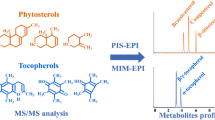Abstract
Phytosterols are recognized as functional food components with cholesterol reducing properties in humans. The formation of phytosterol oligomers as a result of the thermo-oxidative degradation of sitosterol is shown to occur. The existence of oligomers is demonstrated by size exclusion chromatography (SEC) and confirmed by combined SEC-atmospheric pressure chemical ionization mass spectrometry (SEC/APCI-MS). A speculative structure for the sitosterol dimer with 3,7′ linkage is proposed consistent with data from tandem mass spectrometry and exact mass measurements. Higher molecular weight species arising from the formation of trimers or higher oligomers are seen in the mass spectra. Fragments of sitosterol formed by thermo-oxidative processes are also shown to oligomerize and their common structural characteristics are demonstrated by tandem mass spectrometry. The results presented provide evidence for the possible formation of oligomeric species involving sterols in addition to those known for acylglycerides in vegetable oils subjected to extreme oxidative stress such as in frying.










Similar content being viewed by others
Abbreviations
- APCI:
-
Atmospheric pressure chemical ionization
- ELSD:
-
Evaporative light scattering detector
- ESI:
-
Electrospray ionization
- HPLC:
-
High pressure liquid chromatography
- LC/MS:
-
Liquid chromatography–mass spectrometry
- SEC:
-
Size exclusion chromatography
References
Przybylski R, Zambiazi R, Li W (1999) Kinetics of sterols changes during storage and frying of canola oils. In: Proceedings of the 10th international rapeseed congress, 26–29 September, Canberra, Australia
Rudzińska M, Korczak J, Wąsowicz E (2005) Changes in phytosterols and their oxidation products during frying of French fries in rapeseed oil. Pol J Food Nutr Sci 14:381–387
Rudzinska M, Przybylski R, Wasowicz E (2009) Products formed during thermo-oxidative degradation of phytosterols. JAOCS 86:651–662
Kim SK, Nawar WW (1993) Parameters influencing cholesterol oxidation. Lipids 28:917–922
Oehrl LL, Hansen AP, Rohrer CA, Fenner GP, Boyd LC (2001) Oxidation of phytosterols in a test food system. JAOCS 78:1073–1078
Dutta PC (2004) Chemistry, analysis, and occurrence of phytosterol oxidation products in foods. In: Dutta PC (ed) Phytosterols as functional food components and nutraceuticals. Marcel Dekker Inc, New York, pp 397–417
Dutta PC, Appelqvist LÅ (1997) Studies on phytosterol oxides I: effect of storage on the content in potato chips prepared in different vegetable oils. JAOCS 74:647–657
Lampi AM, Juntunen L, Toivo J, Piironen V (2002) Determination of thermo-oxidation products of plant sterols. J Chrom B 777:83–92
Soupas L, Juntunen L, Lampi A-M, Piironen V (2004) Effects of sterol structure, temperature, and lipid medium on phytosterol oxidation. J Agric Food Chem 52:6485–6491
Lercker G, Rodriguez-Estrada MT (2002) Cholesterol oxidation mechanisms. In: Guardiola F, Dutta PC, Codony R, Savage GP (eds) Cholesterol and phytosterol oxidation products. AOCS, Champaign, pp 1–25
Smith LL (1981) Cholesterol autoxidation. Plenum, New York, pp 125–458
Christopoulou CN, Perkins EG (1989) Isolation and characterization of dimmers formed in used soybean oil. JAOCS 66:1360–1370
Li T, Dias JR (1997) Dimeric and oligomeric steroids. Chem Rev 97:283–304
Choe E, Min DB (2007) Chemistry of deep-fat frying oils. J Food Sci 72:77–86
Billek G (2000) Health aspects of thermoxidized oils and fats. Eur J Lipid Sci Technol 102:587–593
Soupas L, Huikko L, Lampi AM, Piironen V (2007) Pan-frying may induce phytosterol oxidation. Food Chem 101:286–297
Lampi AM, Kemmo S, Makela A, Heikkinen S, Piironen V (2009) Distribution of monomeric, dimeric and polymeric products of stigmasterol during thermo-oxidation. Eur J Lipid Sci Technol 111:1027–1034
Clifton P (2002) Plant sterol and stanols—comparison and contrasts: sterols versus stanols in cholesterol-lowering: is there a difference? Atherosclerosis Suppl 3:5–9
Moreau RA, Norton RA, Hicks KB (1999) Phytosterols and phytostanols lower cholesterol. Inform 10:572–577
Hicks KB, Moreau RA (2001) Phytosterol and phytostanols: functional food cholesterol busters. Food Technol 55:63–67
Oehrl DL, Boyd LC (2004) Biological effects and safety aspects of phytosterol oxides. In: Dutta PC (ed) Phytosterols as functional food components and nutraceuticals. Marcel Dekker Inc, New York, pp 419–430
Neff WE, Byrdwell WC (1998) Characterization of model triacylglycerol (triolein, trilinolein and trilinolenin) autoxidation products via high-performance liquid chromatography coupled with atmospheric pressure chemical ionization mass spectrometry. J Chrom A 818:169–186
Byrdwell WC, Neff WE (2004) Electrospray ionization MS of high M.W TAG oligomers. JAOCS 81:13–26
Kemmo S, Ollilainen V, Lampi AM, Piironen V (2007) Determination of stigmasterol and cholesterol oxides using atmospheric pressure chemical ionization liquid chromatography/mass spectrometry. Food Chem 101:1438–1445
Kemmo S, Ollilainen V, Lampi AM, Piironen V (2008) Liquid chromatography mass spectrometry for plant sterol oxide determination in complex mixture. Eur Food Res Technol 226:1325–1334
ISO/FDIS 16931-2009, Animal and vegetable fats and oils: determination of polymerized triglycerides content by high-performance size-exclusion chromatography (HPSEC)
Acknowledgments
This work was financed by the State Committee for Scientific Research, grant # N312 071 32/3209, by the Alberta Value Added Corporation, the Agriculture Funding Consortium project #2006F018R; project #2009FO32R supported by the Agriculture and Food Council of Canada and the Alberta Agricultural Research Institute, and by an NSERC Discovery Grant (to J.M. Curtis).
Author information
Authors and Affiliations
Corresponding author
About this article
Cite this article
Rudzinska, M., Przybylski, R., Zhao, Y.Y. et al. Sitosterol Thermo-oxidative Degradation Leads to the Formation of Dimers, Trimers and Oligomers: A Study Using Combined Size Exclusion Chromatography/Mass Spectrometry. Lipids 45, 549–558 (2010). https://doi.org/10.1007/s11745-010-3433-0
Received:
Accepted:
Published:
Issue Date:
DOI: https://doi.org/10.1007/s11745-010-3433-0




